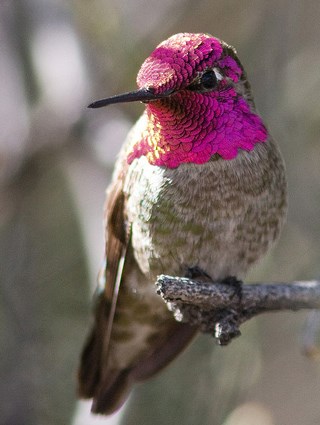You’ve probably seen hummingbirds visiting a vining or bushy collection of flowers, darting from one to another in the blink of an eye. High sucrose nectar powers them. Hummingbirds drink several times their body weight daily. Their long, forked tongues can form two tubes, uncurling to immerse into the nectar, and curling up to capture it. Pollination is incidental. Hummingbirds hover when visiting a flower, much like bees or other insects. With an almost vertical feeding position, it is no surprise that these animals prefer flowers that have relatively flat vertical faces; hummingbird feeders deliver their nectar from such designs. But hummingbirds also visit flowers that hang downwards, hovering in a rather awkward position to do so. Scientists speculate that such flowers are visited because their nectars is well-protected from dilution by rain.
Hummingbirds are in the family, trochilidae, meaning “small bird”. The name might be accurate, but it hardly does this little creature justice. The hummingbird’s unique physiology and flight technique are much closer to that of insects such as bees or hawkmoths, which, as you may remember from a previous Weird Animal edition, were real speedsters. These insects fly with more efficiency because both the down stroke and the upstroke provide lift. Hovering insect wings are supremely flexible, turning inside out with the flying process. Hummingbirds’ wings don’t exhibit that much rotation but they can turn sideways during the flight stroke. Think about how you tread water when your body is vertical. The hummer’s wing movements resemble your arm strokes to keep yourself stationary and erect. This efficiency means the bird uses less energy to fly than its larger counterparts whose wings flap up and down from a shoulder-like appendage. Nonetheless, a hummingbird spends much of its time perching. Flight is reserved for obtaining nectar and catching insects to augment their protein requirements – and for mating rituals.
Mating displays and rituals are where the male hummingbird “shines”. Not only does the male of the species sport an iridescent jeweled coat, but he performs incredible acrobatic feats to prove himself the fittest and win the fair heart of the drabber female. The courtship behavior of Anna’s hummingbird (Calypte anna) has been extensively studied; other species have similar behaviors and feather structures so it seems a safe bet that they use a routine similar to Anna’s to impress a female. During breeding season, male hummingbirds will search for perching females. When he finds a likely spectator he’ll fly straight up, perhaps as high as… feet. Then the bird will tuck back its wings and dive headfirst. At the last second, the descending male fans out his tail features, stopping his fall. He then pulls back the feathers and pulls out of his dive. The sound his tail feathers make in the onrushing wind creates a distinctive chirp, which the female evaluates for its desirable qualities. What is she looking for? First of all, since each species of hummingbird produces a distinctive “tail song” she wants to be sure her potential mate is the same as she is. Then she looks for volume. The louder the sound, the faster the male was falling. It takes a strong male to achieve the highest speeds (and live through it). This is no casual trick. A descending Anna’s hummer can reach speeds over 50MPH – so fast the velocity could rip the bird’s wings off were the chest muscles not able to draw them back out of the friction zone. Measured in terms of the hummingbird’s size this descent is faster than a jet pilot. Pulling out of the fall takes tremendous strength and the ability to withstand up to10 G’s of force; 7 G’s can cause humans to black out. Hummingbirds can pull out so quickly, however, that these forces are only active for a microsecond, thus minimizing the danger to the bird.
 |
| Adult male Anna's Hummingbird. Photo taken by Joan Gellatly, AZ Feb 2009. |
If you enjoy hummingbird visits, install some of their favorite nectar plants in your yard. See the links below. While it is tempting to hang a feeder for them, your visitors will be less stressed feeding nature’s way. A bird feeder invites competition and fighting in this territorial little creature. And remember, our hummingbirds need to head south for the winter. Keeping your feeder up too long will encourage them to stay and risk freezing to death. Flowers know when to begin and to stop blooming, and that will tell your hummers to depart on time and be back with the weather is favorable.
For some cool videos and more information check out the following links:
- High-Speed Video Shows How Hummingbirds Really Drink
- High-Speed Video Investigates Mystery of Hummingbird Pollination
- Hummingbirds get in a unique flap
- Hummingbird Banding Is Like Holding Magic
- Hummingbirds Dive to Sing with Their Tails
- Anna’s hummingbird outflies falcons and fighter pilots
- Florida’s Hummingbirds
- Hummingbird Gardens

No comments:
Post a Comment